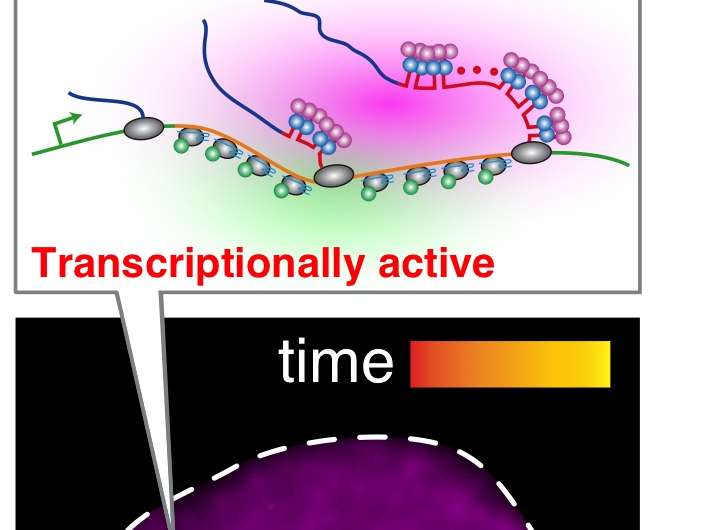Simultaneous live imaging of a specific gene's transcription and dynamics

A Japanese research group has developed a live-imaging method for simultaneous measurements of the transcriptional activity and nuclear position of endogenous genes. This method is used to detect sub-genome-wide mobility changes that depend on the activity of a pluripotency-related gene in mouse embryonic stem cells.
Dr. Hiroshi Ochiai and his colleagues, Dr. Takeshi Sugawara (Research Center for the Mathematics on Chromatin Live Dynamics [RcMcD] at Hiroshima University) and Professor Takashi Yamamoto (Graduate School of Science at Hiroshima University), have established a novel live-imaging method termed the "Real-time Observation of Localization and EXpression (ROLEX)" system. This system enables simultaneous measurements of the transcriptional activity and nuclear position of endogenous genes using MS2 transcription imaging and clustered regularly interspaced short palindromic repeats (CRISPR) gene-imaging techniques.
Dr. Ochiai stated, "By using only existing techniques, such as the chromatin conformation capture (3C)-related method and fluorescence in situ hybridization (FISH) analysis using high-resolution microscopy, it is difficult to explore time-dependent changes in the spatial organization of a genome and gene expression. Acquisition of dynamic information is necessary for comprehensive understanding of higher order gene regulation. Therefore, development of new techniques to analyze the dynamics of gene transcription and spatial organization is required."
The ROLEX system shows high specificity and does not affect the expression level of the target gene. For example, this system enabled detection of sub-genome-wide mobility changes that depend on the transcriptional activity of the Nanog gene, which encodes a key transcription factor for pluripotency, in mouse embryonic stem cells. The ROLEX system is expected to be employed in studies investigating the dynamics of higher-order gene regulation via long-range genomic interactions, and for evaluating whether variability in the genomic organization of cells causes cell-to-cell heterogeneity in gene expression. Such heterogeneity is considered to be related to the resistance of cancer cells to anticancer drugs and to the unequal capability of pluripotent stem cells to differentiate into desired cell types.
Dr. Ochiai further stated, "The ROLEX system will provide unprecedented insight into the relationship between gene transcription and nuclear dynamics in living cells. We believe that the system will become a powerful tool not only in cell biology but also in other fields, including biomedical research and clinical therapy."
These results were published in Nucleic Acids Research. The article's title is "Simultaneous live imaging of the transcription and nuclear position of specific genes."
More information: Nucleic Acids Research, DOI: 10.1093/nar/gkv624
Journal information: Nucleic Acids Research
Provided by Hiroshima University


















